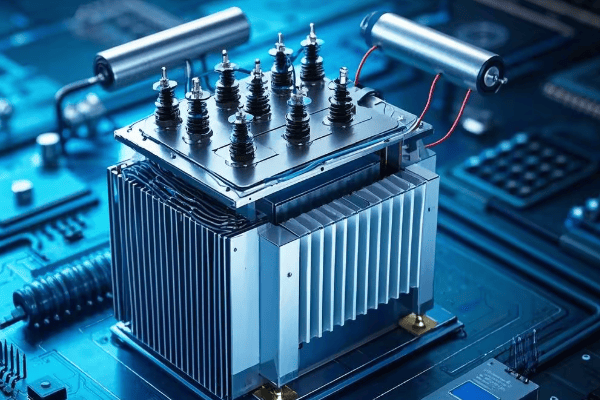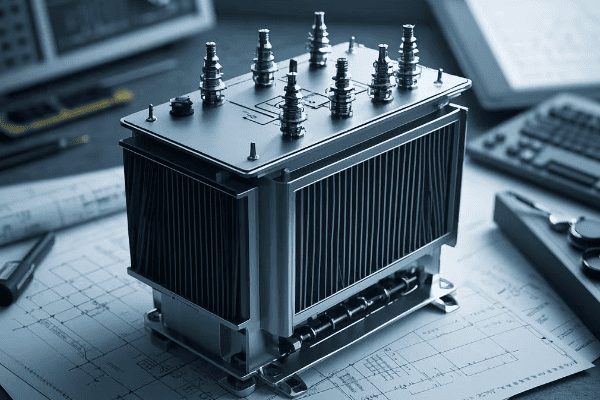Transformer Impedance: Definition, Function, and Its Critical Impact on Power Systems?
Have you ever wondered why some transformers perform better than others in power systems? The secret often lies in a critical parameter called transformer impedance.
Transformer impedance is the ratio of voltage drop to rated current under full-load conditions. It’s crucial because it limits fault currents, affects voltage regulation, and impacts transformer efficiency. Understanding and optimizing impedance is key to designing safe and efficient power systems.

As an electrical engineer with over 15 years of experience in power system design, I’ve seen firsthand how this seemingly simple concept can make or break a power distribution network. Let’s explore the world of transformer impedance and why it’s so important for power system engineers and designers.
What is the definition of transformer impedance?
When I first started working with transformers, I was confused about what impedance really meant in practical terms. It’s a concept that many engineers struggle with at first.
Transformer impedance is the transformer’s resistance to current flow, expressed as a percentage of the rated voltage. It’s calculated by dividing the voltage drop across the transformer at full load by the rated voltage and multiplying by 100.

To understand transformer impedance fully, we need to break it down into its components and representation methods.
How is impedance represented?
Transformer impedance is typically represented in two ways:
-
Percentage Impedance: This is the most common method in the power industry. It’s expressed as a percentage of the rated voltage.
-
Ohmic Value: This is the actual resistance in ohms. It’s less commonly used but can be helpful for detailed calculations.
Here’s a simple table to illustrate the relationship:
| Rated Power | Rated Voltage | Percentage Impedance | Ohmic Value |
|---|---|---|---|
| 1000 kVA | 11 kV | 6% | 7.26 Ω |
| 5000 kVA | 33 kV | 8% | 17.42 Ω |
What’s the relationship between impedance and rated current?
The relationship between impedance and rated current is inverse. Higher impedance means lower fault current, and vice versa. This is crucial for system protection.
For example, in a 1000 kVA transformer with 6% impedance:
- Rated current = 1000 kVA / (√3 * 11 kV) ≈ 52.5 A
- Fault current = 52.5 A / 0.06 ≈ 875 A
This relationship directly affects how much current will flow during a fault condition, impacting the sizing of circuit breakers and other protective devices.
What are the components of transformer impedance?
Understanding the components of transformer impedance is crucial for making better decisions in transformer selection and system design.
Transformer impedance consists of two main components: winding resistance and leakage reactance. The winding resistance is due to the copper or aluminum conductors, while leakage reactance is caused by magnetic flux that doesn’t link both windings.

Let’s examine each component and its impact on transformer performance.
How does winding resistance affect impedance?
Winding resistance is the simpler component to understand. It’s the pure resistance of the conductor material used in the windings, usually copper or aluminum.
Key points about winding resistance:
- It causes I²R losses, also known as copper losses
- It’s relatively small compared to leakage reactance, typically 10-30% of total impedance
- It increases with temperature, which can affect transformer performance in hot conditions
What role does magnetic field reactance play?
Leakage reactance is the more complex and usually larger component of transformer impedance. It’s caused by the magnetic flux that doesn’t link both windings.
Key points about leakage reactance:
- It’s typically 70-90% of total impedance
- It doesn’t cause direct power loss but affects voltage regulation
- It’s influenced by the physical arrangement of windings and core design
What design factors influence impedance?
Several design factors influence transformer impedance:
- Number of winding turns: More turns generally increase impedance
- Core material and design: Affects the magnetic path and leakage flux
- Winding arrangement: Impacts leakage reactance
- Conductor size and material: Affects winding resistance
Understanding these factors helps optimize transformer designs for specific applications, balancing between fault current limitation, efficiency, and voltage regulation.
What is the role of transformer impedance in power systems?
Transformer impedance plays a crucial role in power systems. It’s not just a number on a spec sheet; it significantly impacts system performance and safety.
Transformer impedance is vital in power systems for three main reasons: it limits fault currents, affects voltage regulation, and influences transformer efficiency. These factors are critical for system protection, power quality, and overall performance.

Let’s explore each of these roles in detail.
How does impedance limit fault currents?
One of the most critical functions of transformer impedance is limiting fault currents. This is essential for protecting the transformer and downstream equipment.
Key points about fault current limitation:
- Higher impedance results in lower fault currents
- Helps protect the transformer and downstream equipment
- Allows for the use of lower-rated (and less expensive) circuit breakers
How does impedance affect voltage regulation?
Voltage regulation is another crucial aspect influenced by transformer impedance. This is particularly important in industrial settings with large motor loads.
Key points about voltage regulation:
- Higher impedance leads to poorer voltage regulation
- Affects the voltage drop from no-load to full-load conditions
- Can impact the performance of voltage-sensitive equipment
A simple formula to estimate voltage drop:
Voltage Drop (%) ≈ Impedance (%) × Load Factor × Power Factor
How does impedance impact transformer efficiency?
Transformer efficiency is also affected by impedance, primarily through its resistance component. This can have long-term economic impacts.
Key points about efficiency impact:
- Higher impedance (particularly the resistance component) leads to higher losses
- Affects the transformer’s temperature rise
- Influences long-term operational costs
Why is transformer impedance important?
Transformer impedance is a critical parameter that affects the entire power system’s performance and safety.
Transformer impedance is crucial because it directly impacts system protection, power quality, and energy efficiency. It affects fault current levels, voltage stability, and overall system losses, making it a key consideration in power system design and operation.

The importance of transformer impedance extends to various aspects of system operation and performance.
What is the critical role of impedance in system operation?
Transformer impedance affects several key aspects of system operation:
- System Stability: Impedance affects the system’s ability to maintain synchronism during disturbances.
- Power Flow Control: Impedance influences how power flows through parallel paths in the system.
- Protection Coordination: The impedance value is essential for setting protective relays and coordinating various protective devices.
- Harmonic Mitigation: Higher impedance can help limit the flow of harmonic currents.
How does impedance affect power system performance?
Transformer impedance has a profound impact on overall power system performance:
- Voltage Profile: Impedance affects the voltage drop across the transformer, impacting the entire system’s voltage profile.
- System Losses: While higher impedance can limit fault currents, it also increases system losses.
- Power Quality: Impedance affects various power quality parameters such as voltage sags, swells, and flicker.
- Fault Level Management: In areas with high fault levels, transformer impedance can be used to manage overall system fault levels.
What are the impedance considerations in transformer design?
Designing transformers with the right impedance is a complex task that requires balancing multiple factors.
In transformer design, impedance considerations involve balancing safety, efficiency, and system compatibility. Key factors include fault current limitation, voltage regulation requirements, efficiency targets, and overall system characteristics.

Let’s explore the key considerations in transformer impedance design.
How is safety factored into impedance design?
Safety is paramount in transformer design, and impedance plays a crucial role:
- Fault Current Limitation: Higher impedance limits fault currents, reducing stress on the transformer and connected equipment during short circuits.
- Thermal Performance: Impedance affects the transformer’s temperature rise.
- Mechanical Strength: Higher fault currents (from lower impedance) require stronger mechanical designs.
- Insulation Coordination: Impedance influences voltage transients, affecting insulation requirements.
How can efficiency be optimized through impedance selection?
Efficiency optimization is a balancing act involving several factors:
- Load Profile: Understanding the expected load profile is crucial for selecting the optimal impedance.
- Loss Evaluation: Consider both no-load (core) losses and load (winding) losses.
- Temperature Rise: Lower impedance generally means lower losses and less heating.
- Total Cost of Ownership: Sometimes, a more expensive, lower impedance transformer can be more economical over its lifetime due to lower energy losses.
What system compatibility issues need to be considered?
System compatibility is crucial for optimal performance:
- Parallel Operation: If transformers will operate in parallel, their impedances should be closely matched.
- Existing Fault Levels: In systems with high fault levels, higher impedance transformers might be necessary.
- Voltage Regulation Requirements: Some loads might require tighter voltage regulation, necessitating lower impedance.
- Harmonic Environment: In systems with high harmonic content, slightly higher impedance can help limit harmonic currents.
- Future Expansion: Consider potential future changes in the system when selecting impedance.
Conclusion
Transformer impedance is a critical parameter that impacts safety, efficiency, and overall system performance. As power systems become more complex, understanding and optimizing impedance becomes increasingly important. Whether you’re designing a new system or upgrading an existing one, careful consideration of transformer impedance can lead to safer, more efficient, and more reliable electrical networks.
Free CHBEB Transformer Catalog Download
Get the full range of CHBEB transformers in one catalog.
Includes oil-immersed, dry-type, pad-mounted, and custom solutions.
Quick Message
Request A free quote
We'd like to work with you
- +86 15558785111
- [email protected]
- +86 15558785111
What We Do
CHINA BEI ER BIAN (CHBEB) GROUP, with 218 million in registered capital, originated from Beijing Beierbian Transformer Group. Headquartered in Beijing for R&D, it operates major production bases in Nanjing and Yueqing, producing high-quality products.
Latest Product
address
BeiJing
No 3,RongJing East Road,BeiJing Economic Technological Development Area,BeiJing,China
JiangSu
No 7️Xiangfeng Road,Jiangning,NanJing,JiangSu,China
WenZhou
No.211, Wei 16 Road, Industrial Zone, Yueqing, Wenzhou, Zhejiang, China.
XiangYang Industrial Zone ,YueQing,WenZhou,ZheJiang,China
contact us
- [email protected]
- +86 13057780111
- +86 13057780111
- +86 15558785111
Copyright © Bei Er Bian Group


